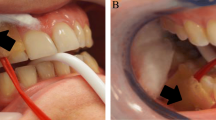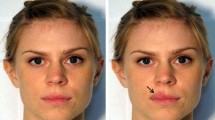Abstract
Atypical odontalgia (AO) is an orofacial pain condition which has been suggested to involve neuropathic pain mechanisms. The aim of this study was to use a brain stem reflex to investigate craniofacial nociceptive mechanisms in AO. In 38 AO patients and 27 matched healthy controls, the R2 component of the blink reflex (BR) was elicited using a “nociceptive-specific” electrode and recorded with surface electromyography electrodes on both orbicularis oculi muscles. The BR was tested by stimulation of both sides of the face of the participants before, during, and after an intraoral pain provocation test with capsaicin. The data were analyzed with three- and four-way mixed-model analyses of variance. The root mean square value of the ipsilateral R2 (R2i) was significantly reduced in patients compared with controls (P=0.046). No differences in R2 between stimulation sides were detected in either group (P>0.757). In all participants, R2 responses and the intensity of the pain evoked by the electrical stimulus were decreased during and after application of capsaicin compared with baseline (P<0.001). In patients, R2i onset latencies were significantly prolonged compared with controls (P=0.031). The present data show disturbances in the central processing of craniofacial information and that endogenous pain inhibitory systems in AO patients and healthy controls were activated to a similar degree by an acute intraoral nociceptive input. Additional clinical research with AO patients will be needed to determine to what extent neuropathic pain mechanisms are involved in this pain condition.



Similar content being viewed by others
References
Aramideh M, Ongerboer de Visser BW (2002) Brainstem reflexes: electrodiagnostic techniques, physiology, normative data, and clinical applications. Muscle Nerve 26:14–30
Baad-Hansen L, Jensen TS, Svensson P (2003) A human model of intraoral pain and heat hyperalgesia. J Orofac Pain 17:333–340
Baad-Hansen L, List T, Jensen TS, Leijon G, Svensson P (2005) Blink reflexes in patients with atypical odontalgia. J Orofac Pain 19:239–247
Baad-Hansen L, List T, Jensen TS, Svensson P (2006) Increased pain sensitivity to intraoral capsaicin in patients with atypical odontalgia. J Orofac Pain (In press)
Campbell RL, Parks KW, Dodds RN (1990) Chronic facial pain associated with endodontic therapy. Oral Surg Oral Med Oral Pathol 69:287–290
Caterina MJ, Schumacher MA, Tominaga M, Rosen TA, Levine JD, Julius D (1997) The capsaicin receptor: a heat-activated ion channel in the pain pathway. Nature 389:816–824
Cliff MA, Green BG (1996) Sensitization and desensitization to capsaicin and menthol in the oral cavity: Interactions and individual differences. Physiol Behav 59:487–494
Drummond PD (2003) The effect of trigeminal nociceptive stimulation on blink reflexes and pain evoked by stimulation of the supraorbital nerve. Cephalalgia 23:534–540
Ellrich J (2000) Brain Stem Reflexes: Probing Human Trigeminal Nociception. News Physiol Sci 15:94–97
Ellrich J, Treede RD (1998) Characterization of blink reflex interneurons by activation of diffuse noxious inhibitory controls in man. Brain Res 803:161–168
Giffin MJ, Katsarava Z, Pfundstein A, Ellrich J, Kaube H (2004) The effect of multiple stimuli on the modulation of the ‘nociceptive’ blink reflex. Pain 108:124–128
Holland GR (1995) Periapical neural changes after pulpectomy. Oral Surg Oral Med Oral Pathol Oral Radiol Endod 80:726–734
Jääskeläinen SK (1995) Electrophysiological study of blink reflex in humans: differences in mental and supraorbital nerves. Acta Physiol Scand 154:143–150
Jääskeläinen SK, Forssell H, Tenovuo O (1999) Electrophysiological testing of the trigeminofacial system: aid in the diagnosis of atypical facial pain. Pain 80:191–200
Jääskeläinen SK, Teerijoki-Oksa T, Forssell H (2005) Neurophysiologic and quantitative sensory testing in the diagnosis of trigeminal neuropathy and neuropathic pain. Pain 117:349–357
Jensen TS, Gottrup H, Sindrup S, Bach FW (2001) The clinical picture of neuropathic pain. Eur J Pharmacol 429:1–11
Katsarava Z, Ellrich J, Diener HC, Kaube H (2002) Optimized stimulation and recording parameters of human ‘nociception specific’ blink reflex recordings. Clin.Neurophysiol 113:1932–1936
Katsarava Z, Lehnerdt G, Duda B, Ellrich J, Diener HC, Kaube H (2003) Sensitization of trigeminal nociception specific for migraine but not pain of sinusitis. Headache 43:425–426
Kaube H, Katsarava Z, Kaufer T, Diener H, Ellrich J (2000) A new method to increase nociception specificity of the human blink reflex. Clin Neurophysiol 111:413–416
Kaube H, Katsarava Z, Przywara S, Drepper J, Ellrich J, Diener HC (2002) Acute migraine headache: possible sensitization of neurons in the spinal trigeminal nucleus? Neurology 58:1234–1238
Klein T, Magerl W, Rolke R, Treede RD (2005) Human surrogate models of neuropathic pain. Pain 115:227–233
Kwan CL, Hu JW, Sessle BJ (1993) Effects of tooth pulp deafferentation on brainstem neurons of the rat trigeminal subnucleus oralis. Somatosens Mot Res 10:115–131
Lautenbacher S, Rollman P (1997) Possible deficiencies in pain modulation in fibromyalgia. Clin J Pain 13:189–196
List T, Leijon G, Helkimo M, Öster A, Svensson P (2005) Effect of local anesthesia on atypical odontalgia - a randomized controlled trial. Submitted
Marbach JJ (1993) Phantom tooth pain: differential diagnosis and treatment. NY State Dent J 59:28–33
Marbach JJ, Hulbrock J, Hohn C, Segal AG (1982) Incidence of phantom tooth pain: an atypical facial neuralgia. Oral Surg Oral Med Oral Pathol 53:190–193
Marbach JJ, Raphael KG (2000) Phantom tooth pain: a new look at an old dilemma. Pain Med 1:68–77
Melis M, Lobo SL, Ceneviz C, Zawawi K, Al Badawi E, Maloney G, Mehta N (2003) Atypical odontalgia: a review of the literature. Headache 43:1060–1074
Mineta Y, Eisenberg E, Strassman AM (1995) Distribution of Fos-like immunoreactivity in the caudal reticular formation following noxious facial stimulation in the rat. Exp Pain Res 107:34–38
Morris VH, Cruwys SC, Kidd BL (1997) Characterisation of capsaicin-induced mechanical hyperalgesia as a marker for altered nociceptive processing in patients with rheumatoid arthritis. Pain 71:179–186
Petersen KL, Fields HL, Brennum J, Sandroni P, Rowbotham MC (2000) Capsaicin evoked pain and allodynia in post-herpetic neuralgia. Pain 88:125–133
Simone DA, Baumann TK, Lamotte RH (1989) Dose-dependent pain and mechanical hyperalgesia in humans after intradermal injection of capsaicin. Pain 38:99–107
Türp JC (2001) Atypical odontalgia—a little known phantom pain. Schmerz 15:59–64
Woda A, Pionchon P (1999) A unified concept of idiopathic orofacial pain: clinical features. J Orofac Pain 13:172–184
Woda A, Tubert-Jeannin S, Bouhassira D, Attal N, Fleiter B, Goulet JP, Gremeau-Richard C, Navez ML, Picard P, Pionchon P, Albuisson E (2005). Towards a new taxonomy of idiopathic orofacial pain. Pain 116:396–406
Acknowledgements
The authors wish to thank Ewa Lööw, Gunilla Johnsson, and Bente Haugsted for skillful assistance in the laboratory and Kritanjli Bajaj for data entry assistance. This study was supported by The Danish Medical Research Council, The Aarhus University Research Foundation, the Danish Dental Association, the Health Research Council in the South-East of Sweden (FORSS), and the Swedish Research Council.
Author information
Authors and Affiliations
Corresponding author
Additional information
This study was supported by The Danish Medical Research Council, The Aarhus University Research Foundation, the Danish Dental Association, the Health Research Council in the South-East of Sweden (FORSS), and the Swedish Research Council.
Rights and permissions
About this article
Cite this article
Baad-Hansen, L., List, T., Kaube, H. et al. Blink reflexes in patients with atypical odontalgia and matched healthy controls. Exp Brain Res 172, 498–506 (2006). https://doi.org/10.1007/s00221-006-0358-1
Received:
Accepted:
Published:
Issue Date:
DOI: https://doi.org/10.1007/s00221-006-0358-1




